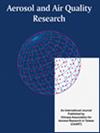Changes in Tropospheric Nitrogen Dioxide Vertical Column Densities over Japan and Korea during the COVID-19 Using Pandora and MAX-DOAS
IF 2.5
4区 环境科学与生态学
Q3 ENVIRONMENTAL SCIENCES
引用次数: 2
Abstract
We investigated the impact of human activity during COVID-19 on the tropospheric nitrogen dioxide vertical column density (NO2 TropVCD) at three urban sites (Gwangju and Busan in Korea and Yokosuka in Japan) and one remote site (Cape Hedo in Japan) from Multi-Axis Differential Optical Absorption Spectroscopy (MAX-DOAS) and Pandora. Compared to the monthly mean NO2 TropVCD from 2015 to 2018 and in 2019, the values were lower in 2020 due to social distancing in Korea and Japan. High negative relative changes were observed from May to September (-30% to -18%) at the three urban sites;Cape Hedo, a remote site, did not show a significant difference in relative changes between previous years and 2020, suggesting that only anthropogenic emission sources decreased dramatically. In the case of Yokosuka, the 15-day moving average of the NO2 TropVCD exhibited a good relationship with transportation (R = 0.48) and industry (R = 0.54) mobility data. In contrast, the NO2 TropVCD at the Korean sites showed a moderate to low correlation with the industrial sector and insignificant correlations with transportation. The differences in correlations might be caused by the different social distancing policies in Korea (voluntary) and Japan (mandatory). By applying generalized boosted models to exclude meteorological and seasonal effects associated with NO2 TropVCD variations, we revealed that the decreasing trend from 2019 to 2020 was much steeper than that from 2015 to 2020 (a factor of two), and a significant change was identified in January 2020, when the first cases of COVID-19 were observed in both Korea and Japan. This result confirmed that the reduction in NO2 can be largely explained by the NOx emission reduction resulting from social distancing for COVID-19 rather than annual meteorological differences;however, in December 2020, NO2 recovered suddenly to its previous level due to an increase in human activities.基于Pandora和MAX-DOAS的COVID-19期间日本和韩国对流层二氧化氮垂直柱密度变化
利用多轴差分光学吸收光谱(MAX-DOAS)和Pandora技术,研究了2019冠状病毒病期间人类活动对三个城市站点(韩国光州和釜山以及日本横须贺)和一个偏远站点(日本合岛角)对流层二氧化氮垂直柱密度(NO2 TropVCD)的影响。与2015 - 2018年和2019年的月平均二氧化氮TropVCD相比,由于韩国和日本的社会距离,2020年的数值较低。5 - 9月,3个城市站点的相对负变化幅度较大(-30% ~ -18%),而偏远站点Hedo Cape的相对变化与前几年相比差异不显著,表明只有人为排放源显著减少。以横须贺为例,NO2 TropVCD的15天移动平均值与交通(R = 0.48)和工业(R = 0.54)流动性数据表现出良好的关系。相比之下,韩国地区的NO2 TropVCD与工业部门的相关性中至低,与交通运输的相关性不显著。相关性的差异可能是由于韩国(自愿)和日本(强制)的社会距离政策不同造成的。通过应用广义增强模型排除与二氧化氮TropVCD变化相关的气象和季节影响,我们发现2019年至2020年的下降趋势比2015年至2020年的下降趋势要大得多(一个2因子),并在2020年1月发现了显著变化,当时韩国和日本都观察到第一例COVID-19病例。这一结果证实,二氧化氮的减少在很大程度上可以通过COVID-19社会距离导致的氮氧化物排放量减少来解释,而不是年度气象差异,但在2020年12月,由于人类活动增加,二氧化氮突然恢复到之前的水平。
本文章由计算机程序翻译,如有差异,请以英文原文为准。
求助全文
约1分钟内获得全文
求助全文
来源期刊

Aerosol and Air Quality Research
ENVIRONMENTAL SCIENCES-
CiteScore
8.30
自引率
10.00%
发文量
163
审稿时长
3 months
期刊介绍:
The international journal of Aerosol and Air Quality Research (AAQR) covers all aspects of aerosol science and technology, atmospheric science and air quality related issues. It encompasses a multi-disciplinary field, including:
- Aerosol, air quality, atmospheric chemistry and global change;
- Air toxics (hazardous air pollutants (HAPs), persistent organic pollutants (POPs)) - Sources, control, transport and fate, human exposure;
- Nanoparticle and nanotechnology;
- Sources, combustion, thermal decomposition, emission, properties, behavior, formation, transport, deposition, measurement and analysis;
- Effects on the environments;
- Air quality and human health;
- Bioaerosols;
- Indoor air quality;
- Energy and air pollution;
- Pollution control technologies;
- Invention and improvement of sampling instruments and technologies;
- Optical/radiative properties and remote sensing;
- Carbon dioxide emission, capture, storage and utilization; novel methods for the reduction of carbon dioxide emission;
- Other topics related to aerosol and air quality.
 求助内容:
求助内容: 应助结果提醒方式:
应助结果提醒方式:


